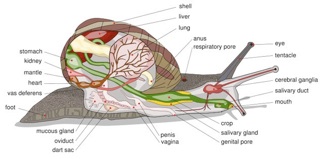Nutrition

Molluscs are animals with three germ layers: endoderm, mesoderm, and ectoderm, characterizing them as triploblastic. They are eucoelomates, organisms having a true coelom, a fluid-filled space around the gut providing more space for organs and surface area for exchange allowing for greater size and complexity of organisms. Molluscs undergo spiral cleavage classifying them as protostomes, whose blastopore eventually becomes the mouth instead of the anus, as it does in echinoderms and chordates.
This image shows the internal, as well as the external, anatomy of the generic snail. Position and advancement in different organs may be altered from species to species depending on how it survives and the habitat in which it resides.
The body plan of a typical mollusk consists of a mantle, which secretes the shell, visceral mass covered with soft skin containing the internal organs and external gill, and a muscular foot specialized for locomotion, for attachment to substrates, or for the capture of food. Most but not all molluscs possess a radula; a rasping organ used for scraping, tearing, or drilling at prey and can sometimes be used to direct food particles into the mouth. This organ is made up of thousands of tiny teeth made of chitin. The primary respiratory organs in molluscs are ctenidia, also referred to as gills. These are made up of ciliated filaments functioning to propel water across the filaments, taking up oxygen and releasing carbon dioxide into and out of the blood through diffusion. Some molluscs obtain respiratory gases in other ways, such as diffusion directly across the mantle or having it modified into air-breathing lungs.
Carychium exile is a species that has, over time, modified its gills into air-breathing lungs, an adaptation common to some land snails. This species, among many others in the class Gastropoda, has undergone torsion, which can be defined as the 180 degree twisting of the visceral mass, bringing the anus and mantle cavity forward to a position above the head, introducing a serious fouling problem having the anus and excretory pores near the gills. In general, most land snails are known as decomposers, helping to break down non-living organic matter, like the leaf litter that they live in and around. A habitat rich in calcium is a preferred one, favoring areas containing dogwood trees, whose leaves and berries are rich in calcium. Loss of such trees reduces the abundance of snails, decreasing the available dietary calcium for other animals, such as birds whose calcium-based eggshells rely on it.
This photo is a picture of leaf litter, where you are most likely to find land snails. Photo courtesy of OzarkLand.com.


